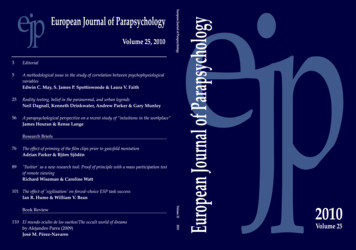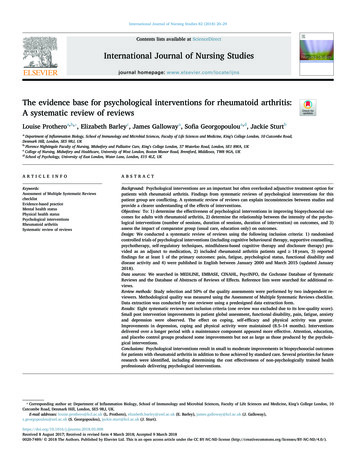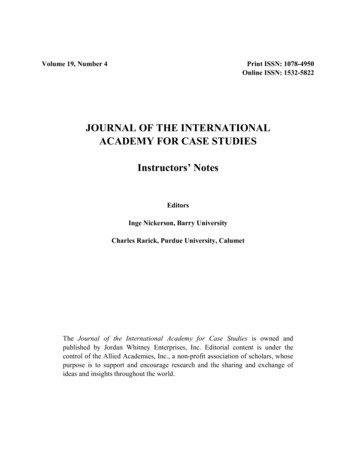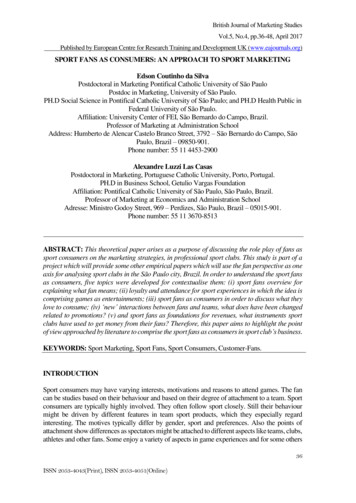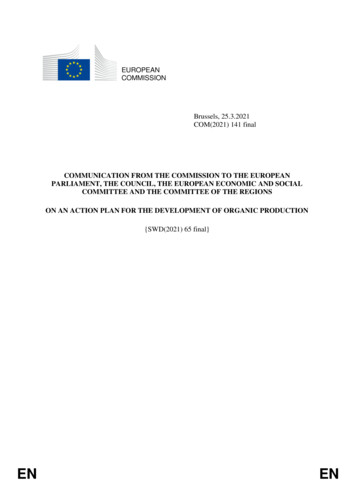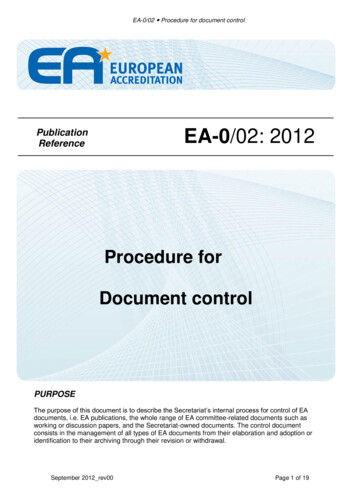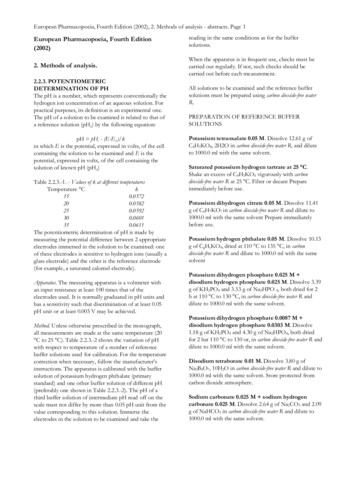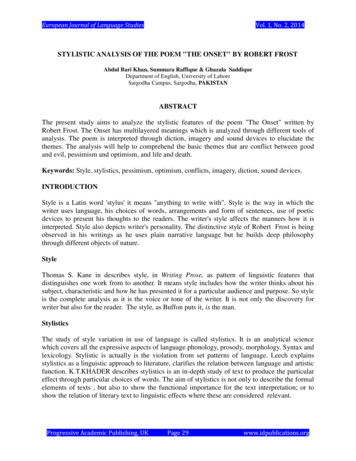
Transcription
European Journal of Language StudiesVol. 1, No. 2, 2014STYLISTIC ANALYSIS OF THE POEM "THE ONSET" BY ROBERT FROSTAbdul Bari Khan, Summara Raffique & Ghazala SaddiqueDepartment of English, University of LahoreSargodha Campus, Sargodha, PAKISTANABSTRACTThe present study aims to analyze the stylistic features of the poem "The Onset" written byRobert Frost. The Onset has multilayered meanings which is analyzed through different tools ofanalysis. The poem is interpreted through diction, imagery and sound devices to elucidate thethemes. The analysis will help to comprehend the basic themes that are conflict between goodand evil, pessimism and optimism, and life and death.Keywords: Style, stylistics, pessimism, optimism, conflicts, imagery, diction, sound devices.INTRODUCTIONStyle is a Latin word 'stylus' it means "anything to write with". Style is the way in which thewriter uses language, his choices of words, arrangements and form of sentences, use of poeticdevices to present his thoughts to the readers. The writer's style affects the manners how it isinterpreted. Style also depicts writer's personality. The distinctive style of Robert Frost is beingobserved in his writings as he uses plain narrative language but he builds deep philosophythrough different objects of nature.StyleThomas S. Kane in describes style, in Writing Prose, as pattern of linguistic features thatdistinguishes one work from to another. It means style includes how the writer thinks about hissubject, characteristic and how he has presented it for a particular audience and purpose. So styleis the complete analysis as it is the voice or tone of the writer. It is not only the discovery forwriter but also for the reader. The style, as Buffon puts it, is the man.StylisticsThe study of style variation in use of language is called stylistics. It is an analytical sciencewhich covers all the expressive aspects of language phonology, prosody, morphology. Syntax andlexicology. Stylistic is actually is the violation from set patterns of language. Leech explainsstylistics as a linguistic approach to literature, clarifies the relation between language and artisticfunction. K.T.KHADER describes stylistics is an in-depth study of text to produce the particulareffect through particular choices of words. The aim of stylistics is not only to describe the formalelements of texts , but also to show the functional importance for the text interpretation; or toshow the relation of literary text to linguistic effects where these are considered relevant.Progressive Academic Publishing, UKPage 29www.idpublications.org
European Journal of Language StudiesVol. 1, No. 2, 2014INTRODUCTION OF THE POET, ROBERT FROST (1874-1964)Robert Frost, an American poet, was born in San Francisco, Califorinia. He is a well-knownmodren poet. He is generally regarded as a poet, teacher, and a man of wisdom. He had aprofound knowledge of literature, history, science and philosophy. Hence he can be termed asclassicist of very high order . Frost neither describes the situations and conditions of life the ofmodern society, nor he writes about political and economic problems of his age. He does notaloof himself from the contemporary society. He has penetrated from social actions tointellectual problems of his age.Frost is a philosophical poet from the start. His aim was not writing poems for charming rusticbut philosophical anxiety, stoical sadness which were obvious in his later work. Philosophicalpoetry deals with questions about life, death and man's destiny in the universe. Frost also raisessuch questions though his answers are vague and often equivocal. Frost does not have anycoherent and systematic philosophy to preach so it is the reason that has made his philosophyambiguous. It means, it is not possible to solve the mystery of universe. Frost believes thatuniverse has three orders of being – man, Nature and God. These three orders are not absolutelydetached from one another but have tendency of configuration. Man builds wall. Natureestablishes zones and seasons. God constructs cosmos. Nture and divine both retrain man'sefforts.As a nature poet Frost does excel many others poets but he does not deify nature. He does notbelieve that nature is all benevolent and benign. Natural disasters are unpredictable. Natureprovides comforts and it is at the same time indifferent to man. Dual characteristic of nature isfound in Frost's poetry. Frost was a working farmer. He took to agricultural activities as avocation. As such he had to contend with various hardships and obstacles. Hence he cannot beexpected to be romantic about nature.INTRODUCTION OF THE POEM "THE ONSET"This poem is taken from the forth volume "New Hampshire" published in 1923. This volume wasa prize winning, first time Robert Frost got the Pulitzer Prize. This volume comprises of wellknown poems as "The Road not taken" ,"The Stopping by woods on Snowy Evening" and "iceand fire". "New Hampshire" manifests peculiar qualities of Robert Frost as self-consciousness,talking about himself and aphorisms. The subject matter of the poems in this collection showsdepth and subtleness. This work depicts his maturity. Frost restrains his emotions even when heis personal. He does not indulge in his feelings. A critic speaking of Frost, says: " It would begoing too far to think of him as a religious poet, but his work tends towards wholeness, thustowards Catholicism at heart".The poem "the Onset" is one among the lyrical poems of Frost. The poem is considered theremaining part of "The Stopping by woods on Snowy Evening", the conflict is representedbetween commitments of life and peacefulness of death so one cannot decide whether to go tofulfill promises or to stay among woods and result is uncertainty and melancholy, on the otherhand the poem "the Onset" presents consentment of poet about the realities of life and death.Here the poet is optimistic about the life though it has miseries and adversities. The idea isProgressive Academic Publishing, UKPage 30www.idpublications.org
European Journal of Language StudiesVol. 1, No. 2, 2014implicit through the seasonal cycle of nature. The poet narrates his feelings about winter andchanging feelings about spring how winter causes destruction and spring comes forreconstruction and spring, after all, leads back to winter. The poem has different themes andinterpretation.METHODOLOGYStylistic analysis will be used to explore the themes through different poetic devices andvocabulary items to understand the poem. The study will examine how the poet has presented thedeep philosophy by using simple narrative language.Theme of the PoemThe theme of the poem is death and life, good and evil and human limitation, that he cannotescape from impending doom so there is no way only to accept it. Man power is limited hecannot understand mysterious nature. The poem is dealing with two opposite extremes andcontrasts as life and death. The subject of the poem is sufferings and comforts, beauty and horror,pessimism and optimism.HANDLING OF THEMETheme is handled through different vocabulary items. "Fated night" suggests the doom of theperson that he cannot escape from the "dark woods" means death."Snow" is evil- because "hissof snow" suggesting serpent- that has occupied the forest with its white clack. It creates terror, sothe speaker stumbles as he is totally captured by the gloom of death.Sadness arises in the first stanza when the poet "Gives up his errand, and lets death descend"manifests that he has surrendered himself before evil because he has no other way to except tosurrender. It shows that man cannot overcome death and evil. He can only accept it with stoicresignation.The feelings of fear and sadness which are appeared in first stanza, now in second stanza turninto hope. Optimism is shown when Frost says "Yet all the precedent on my side". It is a hopewith the arrival of spring that winter has failed to vanish the life from the earth. "The peeper'ssilver croak", "the snow all go downhill" and "like a disappearing snake" potray that hiss of snowhas melted away into slender stream and winter has disappeared like snake. Winter and snakerepresent death and vice, which have gone, now spring has come to regenerate the life."April" again emphasizes the revival of life. It is the month of spring."Nothing will be left whitebut here a birch / And there a clump of houses with a church", these lines shows that evil is notcompletely vanished from the earth. It disappears from the sight for a time. Evil does not reallyleave the world it will again come because symbol of whiteness is linked to snow, winter andcolour of church which threatens that winter will come again. It means triumph of spring is notcomplete. So there is always a tug between evil and good, nothing exists for ever.Progressive Academic Publishing, UKPage 31www.idpublications.org
European Journal of Language StudiesVol. 1, No. 2, 2014POETIC DEVICESSymbolismSymbolism represents ideas indirectly, in it thought or meaning is not conveyed directly. In thepoem night symbolizes sadness due to fated doom. Dark woods represents evil and mystery oflife, one cannot comprehend mysterious things of the world. The symbolic interpretation of winter and snow stands for destruction and eventually causes death. The awareness of deathand evil must persist expression in "The Onset". The most striking of these symbols is found thecomparison between the rill’s of melted snow and a disappearing snake. The transformation ofthe snow into a serpentine stream suggests the fact that evil, though it disappears from sight for atime, does not really leave the world. The symbol of church stands for hope and faith that exitsin this imperfect world. The world is imperfect because of every period is transient whether it isgood or bad. It is symbolized through the seasonal cycle of winter and spring. Life and deathsymbolise spring and winter respectively.IMAGERYImage is the representation of sense experience through language. It appeals human senses tocreate specific description. Visual imagery is shown through "gathered snow", "dark woods","snow may heap", "four feet deep", "houses with a church" in poem (lines 2, 3, 14, 15 and 23).The words "hissing" and "song"signify auditory imagery (line 3 and 5). Kinesthetic imagery islinked to movemen that is shown (line 18 and 21) for example "the snow all go down hill","disappering snake".SimileIt is the comparison of two different things having one feature common, but using some wordand phrase such as like, as. Melting snow is compared to snake in line 21 "like disappearingsnake".MetaphorIt is the comparison of two different things. It is an implied simile without using words such aslike, as or so. The "hissing of snow" in line 4 and 5, is compared to sound of serpent that refers tothe evil. This is the hiss of Satan which is mentioned in Paradise Lost by Milton. Frost too uses itin the same way.HyperboleHyperbole is the exaggeration of detail to render truth. The example of hyperbole can be seen inline 14 and 15 , the snow may heap /In long storms and undrifted four feet deep". Frost here, isgiving exact measurement of falling snow.SOUND DEVICESThe following sound devices are used in the poem "The Onset".Progressive Academic Publishing, UKPage 32www.idpublications.org
European Journal of Language StudiesVol. 1, No. 2, 2014AlliterationThe repetition of initial consonant sounds is called alliteration. In this poem alliterations are"woods and with" (line 3), "four feet" (line15), "see the snow"(line 18),"been begun" (line 11).ConsonanceWhen the final consonant sounds give the same sound, it is consonance. "It shall not make againall" (line 4), "uncovered ground" (line5), "It cannot check the peeper's silver croak" (line 17), "Inwater of a slender April rill" (line 19), "And dead weeds" (line 21) these consonant sounds areused in the poem.AssonanceAssonance is the repetition of similar vowel sounds in words or syllables. "The Onset" presentsstricking repetition of vowols sounds as "Always the same" (line 1), " At last the gathered" (line2), "feet deep" (line 15), "mesured against maple" (line16), the snow all go" (line 18).Rhyme schemeThe poem consists of twenty three lines and it is devided in two stanzas. The rhyme scheme infirst stanza is AABBCCDDEEF.Second stanza has AABBCCDDEEFF rhyme scheme.CONCLUSIONApparently the poem seems about the seasons but when it is analyzed stylistically it revealsdeeper meanings like death and life, by using the symbols of winter and spring. The theme of thepoem is foregrounded through diction, symbols, imagery and metaphors. Frost has depicted theseasonal cycle of nature. In this process destructive side transforms into creative form. This is thepower of nature that controls both forms.Lines 2 & 3- Showing that the snow is white and the woREFERENCES1.Ahmed, M. Practical criticism and literary terms: Lahore.2 Crystal D : 1985; Investigating English Style : Longman Group Limited.3.Geoffrey N. Leech: (2000) A Linguistic Guide To English Poetry Foreign Language Teachingand Research Press.4.Kar33na. (2008, August). Robert Frost’s Poems Retrieved from www.studymode.com5.Poirier,R. (1990). Robert Frost:The work of knowing: with a new afterword. Stanford,Calif:Stanford University Press.6.Tuten,N.L & Zubizarreta, J. (2001). The Robert Frost Encyclopedia.USA: Greenwood t/8.Home: http:// www.shmoop.comProgressive Academic Publishing, UKPage 33www.idpublications.org
European Journal of Language StudiesVol. 1, No. 2, 2014APPENDIXThe OnsetAlways the same, when on a fated nightAt last the gathered snow lets down as whiteAs may be in dark woods, and with a songIt shall not make again all winter longOf hissing on the yet uncovered ground,I almost stumble looking up and round,As one who overtaken by the endGives up his errand, and lets death d
The theme of the poem is death and life, good and evil and human limitation, that he cannot escape from impending doom so there is no way only to accept it. Man power is limited he cannot understand mysterious nature. The poem is dealing with two opposite extremes and contrasts as life and death. The subject of the poem is sufferings and .
